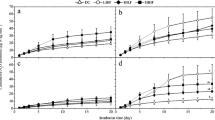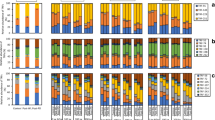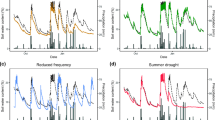Abstract
Aims
As a consequence of global climate change, increases in the frequencies and severities of drought are anticipated for many parts of the world. Soil moisture and nitrogen (N) are among the major factors limiting grassland productivity. In pastures, N fertilizer returns by grazing animals are spatially and temporally heterogenous, and we therefore hypothesized that responses of plants and soil processes to drought may differ at the patch level.
Methods
Using rain-exclusion roofs, we simulated severe summer drought in a three-year field experiment replicated at two grassland sites contrasting in climate and management intensity. The study included a factorial N application treatment encompassing the application of cattle urine and mineral nitrogen. Responses of plants, soil microbes, and soil organic matter were assessed (carbon and nitrogen pools). N2O emissions were measured on 72 dates, and soil N2O concentration profiles on 44 dates.
Results
Plant productivity responded negatively to drought and positively to N application. Interestingly, no or only small drought-effect were found on plant productivity when cumulated over the entire experimental duration, despite large effects during and shortly after the period when rain-exclusion roofs were installed. We further did not find evidence for compensatory growth after drought, and drought-effects did not differ between fertilizer hot spots and unaffected areas. In the short-term, soil microbial biomass responded positively to drought, but no long-term effects were detected. Nitrous oxide (N2O) emissions originated primarily from fertilizer hot spots, and these emissions were massively reduced under drought, with effects lasting throughout most of the growing season. On a growing season basis, N2O emissions were estimated to be 1 to 2 orders of magnitude lower under drought.
Conclusions
Overall, our data suggest that even severe summer drought may have relatively little effect on plant productivity in the type of grassland and climate investigated, at least when considered on an annual basis. In contrast, drought may result in a large and sustained reduction of N2O emissions.


Similar content being viewed by others
References
Auerswald K, Mayer F, Schnyder H (2010) Coupling of spatial and temporal pattern of cattle excreta patches on a low intensity pasture. Nutr Cycl Agroecosyst 88:275–288
Beare MH, Gregorich EG, St Georges P (2009) Compaction effects on CO2 and N2O production during drying and rewetting of soil. Soil Biol Biochem 41:611–621
Brookes PC, Landman A, Pruden G, Jenkinson DS (1985) Chloroform fumigation and the release of soil nitrogen: a rapid direct extraction method to measure microbial biomass nitrogen in soil. Soil Biol Biochem 17:837–842
Carter MS, Klumpp K, Le Roux X (2006) Lack of increased availability of root-derived C may explain the low N2O emission from low N urine patches. Nutr Cycl Agroecosyst 75:91–100
Conrad R (1996) Soil microorganisms as controllers of atmospheric trace gases (H2, CO, CH4, OCS, N2O, and NO). Microbiol Rev 60:609–640
Coughenour MB, Detling JK, Bamberg IE, Mugambi MM (1990) Production and nitrogen responses of the African dwarf shrub Indigofera spinosa to defoliation and water limitation. Oecologia 83:546–552
Davidson EA, Nepstad DC, Ishida FY, Brando PM (2008) Effects of an experimental drought and recovery on soil emissions of carbon dioxide, methane, nitrous oxide, and nitric oxide in a moist tropical forest. Glob Change Biol 14:2582–2590
de Klein CAM, Barton L, Sherlock RR, Li Z, Littlejohn RP (2003) Estimating a nitrous oxide emission factor for animal urine from some New Zealand pastoral soils. Aust J Soil Res 41:381–399
Dobbie KE, McTaggart IP, Smith KA (1999) Nitrous oxide emissions from intensive agricultural systems: variations between crops and seasons, key driving variables, and mean emission factors. J Geophys Res Atmos 104:26891–26899
Dobbie KE, Smith KA (2003) Impact of different forms of N fertilizer on N2O emissions from intensive grassland. Nutr Cycl Agroecosyst 67:37–46
Easterling DR, Meehl GA, Parmesan C, Changnon SA, Karl TR, Mearns LO (2000) Climate extremes: observations, modeling, and impacts. Science 289:2068–2074
Fay PA, Carlisle JD, Knapp AK, Blair JM, Collins SL (2003) Productivity responses to altered rainfall patterns in a C4-dominated grassland. Oecologia 137:245–251
Fierer N, Schimel JP (2003) A proposed mechanism for the pulse in carbon dioxide production commonly observed following the rapid rewetting of a dry soil. Soil Sci Soc Am J 67:798–805
Firestone MK, Davidson EA (1989) Microbial basis of NO and N2O production and consumption in soil. In: Andreae MO, Schimel DS (eds) Exchange of trace gases between terrestrial ecosystems and the atmosphere. John Wiley & Sons Ltd, Berlin, pp 7–21
Flechard CR, Ambus P, Skiba U, Rees RM, Hensen A, van Amstel A, van den Pol-van Dasselaar A, Soussana JF, Jones M, Clifton-Brown J, Raschi A, Horvath L, Neftel A, Jocher M, Ammann C, Leifeld J, Fuhrer J, Calanca P, Thalman E, Pilegaard K, Di Marco C, Campbell C, Nemitz E, Hargreaves KJ, Levy PE, Ball BC, Jones SK, van de Bulk WCM, Groot T, Blom M, Domingues R, Kasper G, Allard V, Ceschia E, Cellier P, Laville P, Henault C, Bizouard F, Abdalla M, Williams M, Baronti S, Berretti F, Grosz B (2007) Effects of climate and management intensity on nitrous oxide emissions in grassland systems across Europe. Agric Ecosys & Environ 121:135–152
Flechard CR, Neftel A, Jocher M, Ammann C, Fuhrer J (2005) Bi-directional soil/atmosphere N2O exchange over two mown grassland systems with contrasting management practices. Glob Change Biol 11:2114–2127
Flessa H, Dörsch P, Beese F (1995) Seasonal variation of N2O and CH4 fluxes in differently managed arable soils in southern Germany. J Geophys Res—Atmos 100:23115–23124
Goldberg SD, Gebauer G (2009) Drought turns a Central European Norway spruce forest soil from an N2O source to a transient N2O sink. Glob Change Biol 15:850–860
Grime JP, Curtis AV (1976) The interaction of drought and mineral nutrient stress in calcareous grassland. J Ecol 64:975–988
Groffman PM, Butterbach-Bahl K, Fulweiler RW, Gold AJ, Morse JL, Stander EK, Tague C, Tonitto C, Vidon P (2009) Challenges to incorporating spatially and temporally explicit phenomena (hotspots and hot moments) in denitrification models. Biogeochem 93:49–77
Haddad NM, Tilman D, Knops JMH (2002) Long-term oscillations in grassland productivity induced by drought. Ecol Lett 5:110–120
Hall MH (1993) Alfalfa growth following release from drought stress. Agron J 85:991–994
Hartmann AA, Buchmann N, Niklaus PA (2011) A study of soil methane sink regulation in two grasslands exposed to drought and N fertilization. Plant Soil 342:265–275
Hawkes CV, Sullivan JJ (2001) The impact of herbivory on plants in different resource conditions: a meta-analysis. Ecology 82:2045–2058
Haynes RJ, Williams PH (1992) Changes in soil solution composition and pH in urine affected areas of pasture. J Soil Sci 43:323–334
Haynes RJ, Williams PH (1993) Nutrient cycling and soil fertility in the grazed pasture ecosystem. Adv Agron 49:119–199
Hedley CB, Saggar S, Tate KR (2006) Procedure for fast simultaneous analysis of the greenhouse gases: methane, carbon dioxide, and nitrous oxide in air samples. Commun Soil Sci Plant Anal 37:1501–1510
Herrmann A, Witter E (2002) Sources of C and N contributing to the flush in mineralization upon freeze-thaw cycles in soils. Soil Biol Biochem 34:1495
Hilbert DW, Swift DM, Detling JK, Dyer MI (1981) Relative growth rates and the grazing optimization hypothesis. Oecologia 51:14–18
Horst GL, Nelson CJ (1979) Compensatory growth of tall fescue following drought. Agron J 71:559–563
IPCC (2007) Climate change 2007—the physical basis. Cambridge University Press, 1009 pp
Jentsch A, Kreyling J, Elmer M, Gellesch E, Glaser B, Grant K, Hein R, Lara M, Mirzae H, Nadler SE, Nagy L, Otieno D, Pritsch K, Rascher U, Schadler M, Schloter M, Singh BK, Stadler J, Walter J, Wellstein C, Wollecke J, Beierkuhnlein C (2011) Climate extremes initiate ecosystem-regulating functions while maintaining productivity. J Ecol 99:689–702
Linn DM, Doran JW (1984) Effect of water-filled pore space on carbon dioxide and nitrous oxide production in tilled and nontilled soils. Soil Sci Soc Am J 48:1267–1272
Loveland TR, Reed BC, Brown JF, Ohlen DO, Zhu Z, Yang L, Merchant JW (2000) Development of a global land cover characteristics database and IGBP DISCover from 1 km AVHRR data. Int J Remote Sens 21:1303–1330
Morecroft MD, Masters GJ, Brown VK, Clarke IP, Taylor ME, Whitehouse AT (2004) Changing precipitation patterns alter plant community dynamics and succession in an ex-arable grassland. Funct Ecol 18:648–655
Nemani RR, Keeling CD, Hashimoto H, Jolly WM, Piper SC, Tucker CJ, Myneni RB, Running SW (2003) Climate-driven increases in global terrestrial net primary production from 1982 to 1999. Science 300:1560–1563
Oesterheld M (1991) Effect of stress and time for recovery on the amount of compensatory growth after grazing. Oecologia 85:305–313
Oesterheld M, McNaughton SJ (1991) Effect of stress and time for recovery on the amount of compensatory growth after grazing. Oecologia 85:305–313
Patra AK, Abbadie L, Clays-Josserand A, Degrange V, Grayston SJ, Loiseau P, Louault F, Mahmood S, Nazaret S, Philippot L, Poly E, Prosser JI, Richaume A, Le Roux X (2005) Effects of grazing on microbial functional groups involved in soil N dynamics. Ecol Monogr 75:65–80
Prieme A, Christensen S (2001) Natural perturbations, drying-wetting and freezing-thawing cycles, and the emission of nitrous oxide, carbon dioxide and methane from farmed organic soils. Soil Biol Biochem 33:2083–2091
Prosser JI (1989) Autotrophic nitrification in bacteria. Adv Microb Physiol 30:125–181
R Development Core Team (2010) R: a language and environment for statistical computing. R Foundation for Statistical Computing. Vienna, Austria. ISBN 3-900051-07-0
Ravishankara AR, Daniel JS, Portmann RW (2009) Nitrous oxide (N2O): the dominant ozone-depleting substance emitted in the 21st century. Science 326:123–125
Rosenzweig ML (1968) Net primary productivity of terrestrial communities—prediction from climatological data. Am Nat 102:67–74
Sanaullah M, Blagodatskaya E, Chabbi A, Rumpel C, Kuzyakov Y (2011) Drought effects on microbial biomass and enzyme activities in the rhizosphere of grasses depend on plant community composition. Appl Soil Ecol 48:38–44
Schär C, Vidale PL, Lüthi D, Frei C, Haberli C, Liniger MA, Appenzeller C (2004) The role of increasing temperature variability in European summer heatwaves. Nature 427:332–336
Sitaula BK, Bakken LR, Abrahamsen G (1995) N fertilization and soil acidification effects on N2O and CO2 emission from temperate pine forest soil. Soil Biol Biochem 27:1401–1408
Smith KA, McTaggart IP, Dobbie KE, Conen F (1998) Emissions of N2O from Scottish agricultural soils, as a function of fertilizer N. Nutr Cycl Agroecosyst 52:123–130
van Haren JLM, Handley LL, Biel KY, Kudeyarov VN, McLain JET, Martens DA, Colodner DC (2005) Drought-induced nitrous oxide flux dynamics in an enclosed tropical forest. Glob Change Biol 11:1247–1257
van Staalduinen MA, Anten NPR (2005) Differences in the compensatory growth of two co-occurring grass species in relation to water availability. Oecologia 146:190–199
Vitousek PM, Howarth RW (1991) Nitrogen limitation on land and in the sea: how can it occur? Biogeochem 13:87–115
Weier KL, Doran JW, Power JF, Walters DT (1993) Denitrification and the dinitrogen/nitrous oxide ratio as affected by soil water, available carbon, and nitrate. Soil Sci Soc Am J 57:66–72
Weslien P, Klemedtsson AK, Borjesson G, Klemedtsson L (2009) Strong pH influence on N2O and CH4 fluxes from forested organic soils. Eur J Soil Sci 60:311–320
White SL, Sheffield RE, Washburn SP, King LD, Green JT (2001) Spatial and time distribution of dairy cattle excreta in an intensive pasture system. J Environ Qual 30:2180–2187
Yamulki S, Harrison RM, Goulding KWT, Webster CP (1997) N2O, NO and NO2 fluxes from a grassland: effect of soil pH. Soil Biol Biochem 29:1199–1208
Zeeman MJ, Hiller R, Gilgen AK, Michna P, Pluss P, Buchmann N, Eugster W (2010) Management and climate impacts on net CO2 fluxes and carbon budgets of three grasslands along an elevational gradient in Switzerland. Agric Forest Meteorol 150:519–530
Acknowledgements
We are indebted to Annika Ackermann, Peter Plüss and Patrick Flütsch for technical support and thank Matthias Zeeman for providing precipitation data for both study sites. Two anonymous reviewers provided helpful comments on an earlier version of this manuscript. This project was conceived by PAN and funded by a Swiss National Science Foundation grant 315230-112681 to PAN. We acknowledge the kind support by Nina Buchmann. AAH gratefully acknowledges ETH Zurich scholarship office for financial support that allowed the completion of this study.
Author information
Authors and Affiliations
Corresponding author
Additional information
Responsible Editor: Hans Lambers.
Electronic Supplementary Material
Below is the link to the electronic supplementary material.
Rights and permissions
About this article
Cite this article
Hartmann, A.A., Niklaus, P.A. Effects of simulated drought and nitrogen fertilizer on plant productivity and nitrous oxide (N2O) emissions of two pastures. Plant Soil 361, 411–426 (2012). https://doi.org/10.1007/s11104-012-1248-x
Received:
Accepted:
Published:
Issue Date:
DOI: https://doi.org/10.1007/s11104-012-1248-x




